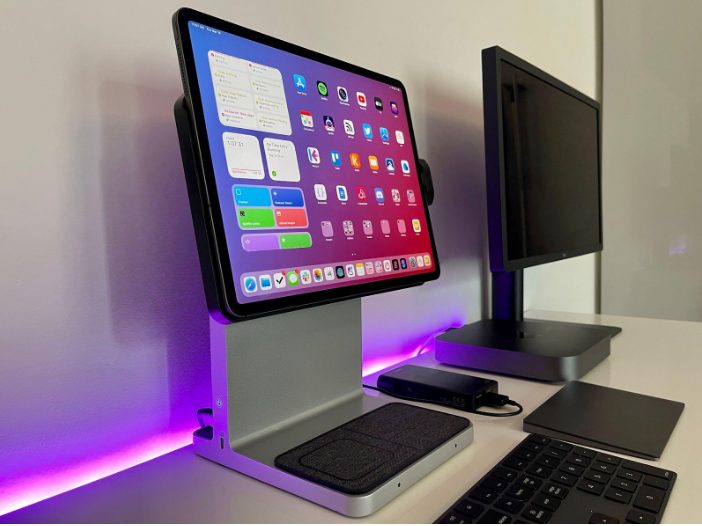Over 1.28 billion people own a tablet such as an Apple iPad or Samsung Galaxy Tab. Bigger than a phone but smaller than a laptop, tablets offer a portable and versatile alternative to traditional desktop computers and have become increasingly common in the modern workplace.
Despite their convenience and mobility, it’s important to recognise the ergonomic risks associated with working on tablets. If not used carefully, tablets can predispose you to muscle and joint pain, and impact your posture, eye health and overall wellbeing.
This blog will explore the ergonomic risks of working with tablets and the proactive measures you can take to prioritise your physical health.

The ergonomic risks of working with tablets
The compact and lightweight nature of tablets can pose certain risks to your musculoskeletal health:
1. Increased strain on your neck and shoulders
The ergonomic risks:
Looking down at a tablet for prolonged periods can put significant pressure on your neck and shoulders, which can lead to the development of a condition called “text neck”. Text neck refers to the overuse of muscles in your head, neck and shoulders, usually resulting from excessive strain on your spine from looking down for long periods. This can cause headaches, neck pain, shoulder and arm pain, compromised breathing and a range of physical problems.
The solution:
Using a tablet stand to elevate your device to eye level can help alleviate the strain on your neck and shoulders.

2. Hand and wrist strain
The ergonomic risks:
Typing on touchscreen keyboards on tablets can be uncomfortable and less efficient due to the lack of tactile feedback and smaller key sizes. Additionally, tablets lack built-in ergonomic designs or wrist rests like traditional keyboards, which can result in unnatural hand and wrist positions and increase the risk of wrist strain.
The solution:
To enhance your typing experience, consider using an external keyboard designed for tablets, which offers better key spacing, tactile feedback and a more traditional typing sensation. Adopt proper hand positioning, use all your fingers for typing and practice touch-typing techniques to help you improve speed and accuracy.
Consider using ergonomic accessories such as tablet stands or attachable wrist rests to provide more support for your hands and wrists and promote a neutral alignment. Try to avoid excessive bending or twisting and take regular breaks to stretch and rest your hands, to reduce strain and discomfort during tablet work.

3. Eye strain
The ergonomic risks:
Working on smaller tablet screens can strain your eyes and cause discomfort as you need to focus more intently. Tablet screens also emit blue light, which can cause dryness and visual fatigue, especially when used for long periods of time.
The solution:
There are several things you can do to reduce eye strain when working with tablets. Adjust your font size, screen brightness, contrast and enable features like night mode or blue light filters for better readability. Take regular breaks and practice eye exercises like looking away from the screen, focusing on distant objects and blinking frequently to combat visual fatigue and maintain healthier vision during tablet working sessions.

How to set up an ergonomic workstation for tablet users
Implement these ergonomic measures to improve comfort, reduce your risk of musculoskeletal issues and enhance your productivity when working with tablets:
- Adjust your desk or table height so your arms and shoulders are at a comfortable 90-degree angle when relaxed.
- Use an adjustable stand or mount to position your tablet at eye level, reducing neck strain and promoting a neutral posture.
- Consider using a separate keyboard and mouse for added comfort and precision. Place your external keyboard and mouse at an appropriate height for comfortable elbow positioning.
- Support your forearms and wrists with ergonomic accessories like wrist rests to maintain a neutral position and prevent strain.
- Ensure your workspace has adequate lighting to reduce eye strain.
- Position your tablet and other screens to minimise glare and reflections.
- Take regular breaks every 30 minutes or so. Sitting in one position for too long can cause fatigue, aching joints and a decrease in productivity. During these breaks, you can do some posture exercises, stretches, or just get up and move for a bit. Our 5-minute stretching videos in VIDA Pain Coach are the perfect way to stay active and healthy during the working day.

Working on tablets poses ergonomic challenges that can affect our wellbeing. However, we can address these challenges by implementing the proactive strategies outlined above to reduce risks and contribute to a healthier tablet work experience.





